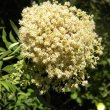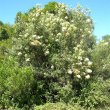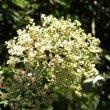| Botanical Name |
|
| Family |
Buddlejaceae - The buddleja family. |
| Pronunciation |
|
| Common Name(s) |
Afrikaans: Witolien; Basterolienhout
IsiZulu: iGqeba-elimhlope
|
| Plant Group |
- Tree A woody, self-supporting perennial plant usually with a single main stem and generally growing more than 6 meters tall.
|
| Plant Size |
- Small
| Tree | 4m to 8m |
| Shrub | 50cm to 75cm |
| Perennial/ground cover | 10cm to 20cm |
| Bulb | 20cm to 30cm |
| Succulent | 10cm to 20cm |
|
| Position |
- Partial Shade The area is in shade for part of the day and in full sun for part of the day.
- Sun The area is in full sun for all or most of the day, all year round.
|
| General Information |
- Drought Tolerance: High The plant is well adapted to arid conditions; it can survive long periods of drought and high temperatures without extra water.
- Evergreen Plants that have leaves all year round.
- Fragrant / Aromatic These plants posses a strong, usually pleasant odour.
- Frost: Hardy The plant can withstand freezing temperatures or frost without artificial protection.
- Prune hard after flowering Fast growing shrubs that grow lanky within a season. Cut off branches and stems of these plants to a third of their original length. This will increase the yield of flowers, improve the plants shape and enhance the structural strength of main branches.
- Roots Non-invasive Safe to plant near pools, paving, walls or buildings.
- Sand tolerant Plants adapted to survive in nutrient poor, very sandy soils.
- Water Wise Plant species originating from low rainfall regions that require less water to survive and thrive than other plant species.
- Wind Tolerant Plants able to withstand the effect of strong winds.
|
| Specific Information |
Buddleja saligna is an especially useful tree for use as a pioneer plant or windbreak in new gardens as it grows fast, soon providing shade, mulch and shelter for slower-growing trees or shrubs. Buddleja is popular among bee farmers as the flowers produce large amounts of pollen and nectar.
|
| Ad Break |
|
| Flowers |
| Description |
tiny, tubular flowers in dense clusters
|
| Season |
- Spring to Summer Plants will seldom bloom for the entire season as given in the list, but should flower during a period within these parameters.
|
| Colour |
|
| Growth Rate |
- Fast Specifying growth rate can be very misleading as there is considerable variation of growth rate depending on type and species of plant, available water, supplementary feeding, mulching and general care, as well as the plants suitability and adaptability to the garden environment.
|
| Plant Uses |
- Attracts bees, butterflies or other insects This plant attracts insects which can be food for birds or other creatures in your garden.
- Attracts Birds This plant will attract birds.
- Boundary A plant useful for planting around the edges of the property to form a green or colourful backdrop, an impenetrable hedge, to hide walls or create privacy.
- Hedge Suitable trees or shrubs planted relatively close together so that the branches intertwine to create a barrier. This can be formal – the plants are regularly trimmed to produce a neat shape, or informal – the plants are left to themselves to create a natural hedgerow.
- Pioneer for new gardens A very fast growing plant, able to withstand hardship, that can be used to populate land that has recently been cleared of natural vegetation. These plants pave the way for slower-growing species by adding nutrients to the soil and creating leaf litter.
- Provides light / dappled shade A tree with an open to sparse canopy, through which varying degrees of sunlight can penetrate.
- Screen A tall hedge of suitable plants planted closely together and used as a windbreak, to block a bad view, to separate parts of the garden or as a backdrop.
- Suitable for coastal gardens Plants adapted to dry, sandy soil, forceful wind, limited rainfall and intense sunlight.
- Wild Garden An indigenous garden planted for the benefit of wildlife and birds. Provides food, water, a variety of mini-biomes and no poisonous chemicals are used.
- Windbreak Trees planted in a row to form protection from prevailing winds by breaking the force of the wind, thereby reducing wind damage.
|
| Distribution and Habitat |
from the Western Cape throughout South Africa, except for the drier central and north-west areas, to Zimbabawe, on forest margins and dry hillsides, in mixed scrub, coastal bush and wooded valleys, and along streams
|
| Planting Suggestions |
|
| Medicinal Uses |
In traditional medicine the leaves are used to treat coughs and colds and the roots are used as a purgative The intense heat with which the wood burns make it useful for fuel.
|
| Ad Break |
|










Comments
False Olive dying
Hi There.
we just planted a false olive tree and 2 weeks into it, it seems like the tree is dying...is there anything we can do to save it before the tree dies? the leaves seems droopy and dry.
Wanda
Hi Wanda
Hi Wanda
All I can suggest is to give it a long, deep soaking. If that doesn't perk it up then it may well die. Unfortunately I can't give you a reason for this problem as I have too little information and there are so many variables.
Kind regards
Lorraine
Feedback
Hi Lorriane
We'll you were right! We just give it lots of water and it made a stunning comeback with flowers!
Buddleja recovery
Hi Wanda
I am so pleased. After flowering is over, I cut my Buddlejas back by a third to a half, depending on how lanky the stems have become. This keeps the plant neat and dense. As the new growth becomes 'floppy', I then tip back the growing buds to encourage branching. I stop pinching back by about July to August to allow the plant to set buds before spring.
Kind regards
Lorraine
buddelja tree
how messy is this tree? Can it be located near a pool without causing a maintenance nightmare?
Buddleja near pool
Hi Anthony
Except during flowering season, it should be no messier than any other evergreen tree.
Kind regards
Lorraine
False Olive
Hi
Do you know where I can purchase seeds from or plantlets from. I am in KZN.
Many thanks
Lorraine
Seeds and seedlings
Hi Barry
You can try the following seed suppliers for seed:
http://www.sanbi.org/gardens/kirstenbosch/kirstenbosch-nbg-seedroom
silverhillseeds.co.za
http://www.seedsforafrica.co.za/
http://www.bidorbuy.co.za/
For plantlets, you would have to approach a few nurseries in your area, find out if their wholesale suppliers carry seedlings of the plant, and request the nursery to order the plants for you.
Alternatively, if you have access to an adult plant, you can grow the plants from cuttings - the cuttings take quite easily. Come back to me if you need information regarding cuttings.
Kind regards
Lorraine
Cuttings
Hi Lorraine. I would like to make cuttings from an adult plant. Please will you give me more info on how to do so.
Making cuttings
Hi Lindie
Buddlejas grow easily from cuttings. I have listed some sites that explain how cuttings are made, and added my own suggestions below:
http://www.bhg.com/gardening/yard/garden-care/starting-flowers-from-cutt...
http://www.bbc.co.uk/gardening/basics/techniques/propagation_summercutti...
https://www.youtube.com/watch?v=WyXSNzywqvw
Summary:
Fill a plant pot or tray with well-drained potting soil mixed about 50/50 with coarse sand, vermiculite or perlite and moisten well before you make your cuttings.
Make your cuttings in the early morning, keep them moist in a bag and plant them as soon as they are prepared.
Choose stems for cuttings that have a firm stem - not green and floppy and not thick and woody.
Prepare the cuttings for planting:
NB: Don't strip the leaves off Buddleja - this will tear strips off the stem. Rather cut the leaves off very close to the stem using a sharp pair of scissors. Make a clean cut about two millimeters below a node, i.e. where the leaves come out of the stem.
I seldom bother with a rooting hormone - especially with Buddleja.
Make a hole with a knitting needle, pencil or (my favourite) the thin end of a chopstick. Push the cutting into the hole and press gently around the cutting so that it is firmly set in the soil. Water the cuttings lightly.
I think that the guy in the video suggests too much water - I prefer to plant into soil that is already moist and you can always add a bit more water later, but you don't want a pool of water in the bottom of the bag. I prefer to cover my trays or pots with white plastic bin bags - not see through plastic.
Don't be tempted to tug on the cuttings to see if they have rooted for at least a month, and when you do, tug very gently. If the cutting is still loose, it has not started rooting. If the cutting resists even just a little, don't tug harder or you may break the tenuous new roots off.
If there is anything you are not sure of, just ask. All the best with your venture.
Kind regards
Lorraine
Making cuttings
Hi Lindie
Buddlejas grow easily from cuttings. I have listed some sites that explain how cuttings are made, and added my own suggestions below:
http://www.bhg.com/gardening/yard/garden-care/starting-flowers-from-cutt...
http://www.bbc.co.uk/gardening/basics/techniques/propagation_summercutti...
https://www.youtube.com/watch?v=WyXSNzywqvw
Summary:
Fill a plant pot or tray with well-drained potting soil mixed about 50/50 with coarse sand, vermiculite or perlite and moisten well before you make your cuttings.
Make your cuttings in the early morning, keep them moist in a bag and plant them as soon as they are prepared.
Choose stems for cuttings that have a firm stem - not green and floppy and not thick and woody.
Prepare the cuttings for planting:
NB: Don't strip the leaves off Buddleja - this will tear strips off the stem. Rather cut the leaves off very close to the stem using a sharp pair of scissors. Make a clean cut about two millimeters below a node, i.e. where the leaves come out of the stem.
I seldom bother with a rooting hormone - especially with Buddleja.
Make a hole with a knitting needle, pencil or (my favourite) the thin end of a chopstick. Push the cutting into the hole and press gently around the cutting so that it is firmly set in the soil. Water the cuttings lightly.
I think that the guy in the video suggests too much water - I prefer to plant into soil that is already moist and you can always add a bit more water later, but you don't want a pool of water in the bottom of the bag. I prefer to cover my trays or pots with white plastic bin bags - not see through plastic.
Don't be tempted to tug on the cuttings to see if they have rooted for at least a month, and when you do, tug very gently. If the cutting is still loose, it has not started rooting. If the cutting resists even just a little, don't tug harder or you may break the tenuous new roots off.
If there is anything you are not sure of, just ask. All the best with your venture.
Kind regards
Lorraine
Pruning
Hi, I know this is a bit late but still worth a try.
My Buddleja saligna is planted in a pot and has been for two years. In that time I have kind of left it to do what it wants. The result of this is that it has now grown bery long dominant branches that are comparible in length, but not width or density, to the main plant. I now want to encourage the plant to grow as a tree with a thick trunk.
The plant stands at a very measy 5ft with it's main density at about 2.5-3ft. How would I go about neating it up and encouraging a thick trunk now? If and when should I prune?
Pruning Buddleja
Hi Julian
My abject apologies for taking so long to reply.
Buddleja can stand really heavy pruning. I recently pruned my 5 meter buddlejas down to a maximum of one meter and they have completely revived and are thick and bushy.
I would cut all stems way back to the shape you require. When the shoots are about 15 cm long, I would tip off the growth points and continue doing this whenever the subsequent shoots have grown and are looking a bit long. The plant may not flower this season but it will be worth doing and will be ready for a good show next year. Once established prune back in autumn or early winter.
As the plant is in a pot it will need some slow release fertilizer like Bounceback, then put a thick layer of mulch (leaves/woodchips...) over the fertilizer. Clay pots are notorious for drying out very quickly so make sure it gets enough water.
Kind regards
Lorraine
Cuttings
Hi Lorraine
Can one make cuttings from a young trees as well?
Taking cuttings
Hi Michelle
Cuttings can be made as soon as the shrub has stems that are a year old. I have found that tip cuttings of very soft, new stems are not successful. Cuttings from the previous season's branches are best.
Kind regards
Lorraine
Buddleja Saligna with gummosis
Hi, we have numerous Buddlejas in our estate which are dripping gummosis...what should one do? cut back, feed mulch?
many thanks,
Gum or nectar?
Hi Karen
I must admit I have not come across this in Buddleja and the wood is not known to be gummy. If the plants are in flower, as they should be at this time of the year, the 'gum' would be nectar as the flowers produce copious keepers.
As to pruning, this can be done during autumn if required, while the plants are young but as they become taller I just leave them to grow naturally. Feeding is rarely necessary unless the plants are not growing well but mulch is always a good idea for all plants.
Kind regards
Lorraine
Discuss this plant
Share knowledge, ask a question or give an experience.